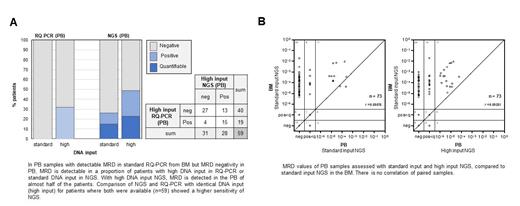Background:
In acute lymphoblastic leukemia (ALL), measurable residual disease (MRD) is the most important prognostic factor. MRD is traditionally quantified in bone marrow aspirates (BM) using real-time quantitative polymerase chain reaction (RQ-PCR) according to EuroMRD standards. Since the emergence of modern molecular methods, it has been a continuous effort to enable MRD assessment from peripheral blood (PB). The less invasive material collection would allow closer MRD monitoring and solve technical challenges of BM aspiration, such as skewed or non-representative MRD values due to hemodilution and unequal distribution of leukemic cells. While several studies demonstrated comparable MRD values of BM and PB in T-ALL, in B-cell precursor ALL (BCP-ALL) MRD determination from PB is still a challenge. Mean MRD levels in PB are considerably lower than in BM and frequently escape detection. Additionally, paired samples show a highly variable MRD level ratio in both pediatric and adult cases (Kotrova et al, Leukemia 2020).
Objective:
BCP-ALL cases with known MRD positivity in the BM likely also harbor MRD positive cells in the PB, even when missed by traditional methods. With more sensitive assays, either by increased DNA input or by application of amplicon-based next generation sequencing (NGS), MRD detection from PB may improve in these cases.
Methods:
We retrospectively selected PB - BM sample pairs of 74 BCP-ALL patients with BM MRD positivity (43 with quantifiable MRD positivity and 31 with positivity below quantitative range) and sufficient leftover DNA from a cohort of patients treated according to GMALL protocols, where conventional RQ-PCR of clonal immunoglobuline heavy chain (IGH) VJ/DJ gene rearrangements failed to detect PB MRD. MRD had been determined by standard RQ-PCR with 1.5 µg DNA in BM and PB, respectively, according to the EuroMRD guidelines (van der Velden et al, Leukemia 2007). PB samples were re-tested for MRD with high DNA input RQ-PCR using 6.6 µg DNA and amplicon-based NGS, each using 6.6 µg DNA, as well as standard input NGS. NGS analyses of corresponding PB and BM samples were performed with the EuroClonality amplicon-based NGS assay (Brüggemann et al, Leukemia 2019). Identification and quantification of leukemia-derived clonotypes was done using ARResT/Interrogate.
Results:
In total, 74 BCP-ALL patients with pre/c-B-ALL (n=60) and pro-B-ALL (n=14) were included. Patient age ranged from 19 - 71 years with a median of 44.5. In all included samples (56 in first-line therapy and 18 salvage treatment), BM was MRD positive and PB was MRD negative in standard RQ-PCR at a sensitivity of at least 10 -4.
To assess the effect of high DNA input alone, RQ-PCR was repeated in PB with high DNA input for 59 patients and 63 IGH VJ/DJ markers. At least one positive signal was detected in 19/59 patients (32%) and 20/63 markers (32%) (FIGURE 1A).
NGS was performed for 73 PB samples and 84 markers using standard and high DNA input. With standard DNA input, MRD could be detected for 19/73 patients (26%) and 21/84 markers (25%) (FIGURE 1A). In the high input approach, MRD was detected in 36/73 patients (49%) and 40/84 markers (48%) (FIGURE 1A). A quantifiable MRD value was identified in 17 patients and 19 markers. All markers with quantifiable NGS MRD positivity in PB showed higher MRD values in the corresponding BM sample and MRD values below 10 -4 (FIGURE 1B). No correlation of MRD in paired samples could be demonstrated (Pearson correlation coefficient: 0.09) (FIGURE 1B).
Conclusion:
In BCP-ALL, MRD detection from PB is challenging with conventional methods. Increased DNA input and amplicon-based NGS allowed detection of MRD in a subset of PB samples that were negative in standard RQ-PCR. With identical DNA input, NGS showed a higher sensitivity than RQ-PCR and best results were achieved when high DNA input and NGS were combined, identifying MRD in nearly half of the PB samples. These results demonstrate that PB can be a valuable tool for early MRD detection in BCP-ALL when adjusting traditional MRD assessment strategies. However, in half of the samples, MRD was still missed by high input NGS. Even with assays improved for sensitivity, PB therefore cannot fully replace BM for MRD assessment in BCP-ALL yet and should rather be considered to complement BM analyses or in cases where BM is not accessible.
Disclosures
Bendig:Amgen: Research Funding. Baldus:Astellas: Consultancy; BMS: Consultancy; AstraZeneca: Consultancy; Amgen: Consultancy; Jazz Pharmaceuticals: Consultancy; Gilead: Consultancy; Jannsen: Consultancy. Goekbuget:Novartis: Research Funding; Pfizer: Honoraria, Research Funding; Jazz: Honoraria, Research Funding; Incyte: Honoraria, Research Funding; Autolus: Honoraria; Clinigen: Honoraria, Research Funding; Servier: Honoraria, Research Funding; Gilead: Honoraria, Research Funding; Amgen: Honoraria, Research Funding. Brüggemann:Incyte: Membership on an entity's Board of Directors or advisory committees; BD: Speakers Bureau; Janssen: Speakers Bureau; Pfizer: Speakers Bureau; Regeneron: Research Funding; Amgen: Membership on an entity's Board of Directors or advisory committees, Research Funding, Speakers Bureau; Affimed: Research Funding.


This feature is available to Subscribers Only
Sign In or Create an Account Close Modal